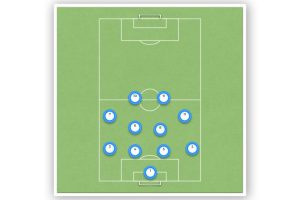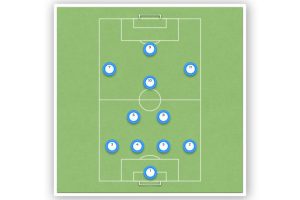The 4-2-3-1 Formation: A Comprehensive Guide to Its Tactics and Advantages
The 4-2-3-1 formation is a popular tactical system used in modern soccer. It is a versatile formation that can be used both offensively and defensively, and it is often favored by coaches who value possession-based play. The formation consists of four defenders, two central midfielders, three attacking midfielders, and one striker.
One of the main advantages of the 4-2-3-1 formation is its flexibility. The three attacking midfielders can be used in a number of different ways, depending on the opposition and the game situation. For example, they can be used to create overloads on the wings, to provide support to the lone striker, or to play through the middle. The two central midfielders (read more on a double pivot in a 4-2-3-1) provide a solid defensive base, while the four defenders ensure that the team is well-protected at the back.
However, the 4-2-3-1 formation is not without its weaknesses. One potential issue is that the lone striker may become isolated if the attacking midfielders are not able to provide enough support. Another issue is that the formation can be vulnerable to counter-attacks if the two central midfielders are caught out of position. Nevertheless, with the right players and the right tactics, the 4-2-3-1 formation can be a highly effective system for any team to use.
History
The 4-2-3-1 formation is a modern tactical system that has gained popularity in recent years. Its origins can be traced back to the 1970 Brazil World Cup-winning team, which was led by legendary coach Mario Zagallo. The team played with a formation that had four defenders, two central midfielders, three attacking midfielders, and one striker. This formation is considered the precursor to the 4-2-3-1 formation that is widely used today.
However, it wasn’t until the 1990s that the 4-2-3-1 formation started to become popular in Europe. The Dutch team, under the guidance of coach Louis van Gaal, used the formation in the 1995 Champions League final against AC Milan. Although they lost the game, the formation caught the attention of many coaches and soon became a popular choice.
One of the reasons why the 4-2-3-1 formation has become so popular is because of its flexibility. It allows teams to have a solid defensive structure while also providing attacking options. The two central midfielders provide a shield for the defense, while the attacking midfielders can create chances for the lone striker.
| Advantages | Disadvantages |
|---|---|
| Provides balance between defense and attack | Requires a high level of tactical discipline from players |
| Allows for quick transitions between defense and attack | Can be vulnerable to counter-attacks if the attacking midfielders don’t track back |
| Provides a solid defensive structure with two central midfielders | Requires a high level of technical ability from the attacking midfielders |
Today, many top teams and coaches use the 4-2-3-1 formation, including Manchester City, Paris Saint-Germain, and Bayern Munich. The formation has also been used by national teams, including Germany and Spain.
Overall, the 4-2-3-1 formation has proven to be an effective tactical system that provides balance between defense and attack. Its flexibility and solid defensive structure make it a popular choice for many teams and coaches.
Tactical Overview
Formation Basics
The 4-2-3-1 formation is a popular tactical shape in modern football. It is a versatile formation that allows for both defensive solidity and attacking fluidity. The formation is made up of four defenders, two central defensive midfielders, three attacking midfielders, and one striker. The defense is made up of a traditional back four with two central defenders and a left and right fullback. Ahead of the defense are two central defensive midfielder players who are responsible for protecting the defense and breaking up opposition attacks. The three attacking midfielders are positioned in front of the two central defensive midfielders, with the central attacking midfielder playing in a slightly more advanced position. The lone striker is positioned up front and is responsible for scoring goals.
Roles and Responsibilities
In the 4-2-3-1 formation, each player has a specific role and responsibility. The two central defenders are responsible for marking the opposition strikers and clearing the ball out of danger. The left and right fullbacks have both defensive and attacking responsibilities. They are responsible for marking the opposition wingers and providing width in attack. The two central defensive midfielders are responsible for protecting the defense and breaking up opposition attacks. The central attacking midfielder is responsible for creating chances for the team and linking up with the lone striker. The two wide attacking midfielders are responsible for providing width in attack and supporting the lone striker. The lone striker is responsible for scoring goals and holding up play.
Strengths and Weaknesses
The 4-2-3-1 formation has several strengths and weaknesses. One of the strengths of the formation is that it provides a solid defensive base with two central defensive midfielders protecting the defense. It also allows for attacking fluidity with three attacking midfielders supporting the lone striker. The formation is also versatile and can be adapted to suit different styles of play. One of the weaknesses of the formation is that it can be vulnerable to counterattacks if the two central defensive midfielders are caught out of position. It can also be difficult to break down teams that play with a deep defensive block.
| Strengths | Weaknesses |
|---|---|
| Provides solid defensive base | Vulnerable to counterattacks |
| Allows for attacking fluidity | Difficult to break down deep defensive blocks |
| Versatile and adaptable |
Famous Teams That Used The 4-2-3-1 Formation
The 4-2-3-1 formation has been used by many successful teams in recent years. One of the most famous examples of a team that has utilized this formation is Pep Guardiola’s Manchester City. Guardiola is known for his tactical acumen and his teams often play with a fluid and attacking style. Manchester City’s success in recent years has been largely due to their ability to dominate possession and create scoring opportunities using the 4-2-3-1 formation.
Another team that has had success with the 4-2-3-1 formation is Tottenham Hotspur. Under the guidance of Mauricio Pochettino, Tottenham has become one of the most consistent teams in the English Premier League. The 4-2-3-1 formation has allowed Tottenham to control the midfield and create scoring opportunities for their attacking players.
Real Madrid is another team that has used the 4-2-3-1 formation to great effect. In the 2014 Champions League final, Real Madrid defeated Atletico Madrid 4-1 with a dominant performance that showcased the strengths of the 4-2-3-1 formation. Real Madrid’s midfield duo of Luka Modric and Toni Kroos controlled the game and provided the platform for Cristiano Ronaldo to score a decisive goal.
| Team | Manager | Success with 4-2-3-1 |
|---|---|---|
| Manchester City | Pep Guardiola | Premier League champions (2017-18, 2018-19, 2019-20) |
| Tottenham Hotspur | Mauricio Pochettino | Champions League runners-up (2018-19) |
| Real Madrid | Carlo Ancelotti | Champions League winners (2013-14) |
Other teams that have used the 4-2-3-1 formation include the German national team, who won the 2014 World Cup using this formation, and the Dutch national team, who reached the final of the same tournament. The 4-2-3-1 formation has become increasingly popular in modern football due to its flexibility and ability to control the midfield.
How To Apply The 4-2-3-1 Formation
Player Selection
When selecting players for the 4-2-3-1 formation, it is important to consider their individual strengths and weaknesses. The formation requires a strong and reliable goalkeeper, two solid center backs who can communicate well and cover each other, and two full-backs who are comfortable going forward to support the attack but can also track back quickly to defend.
In midfield, the two central midfielders should be disciplined and comfortable in possession, with one player acting as the anchor and the other as a box-to-box midfielder. The three attacking midfielders should be creative and dynamic, with the ability to interchange positions and link up with the lone striker.
The lone striker should be a clinical finisher with good hold-up play and the ability to bring others into the game. Overall, the team should be well-balanced and able to work together to create and score goals while remaining defensively solid.
Training and Drills
Training and drills are essential to ensure that players understand their roles and responsibilities within the 4-2-3-1 formation. Defensive drills should focus on communication, positioning, and covering for each other, while attacking drills should focus on movement, passing, and finishing.
One effective training drill is the “rondo,” which involves a small-sided game in which the attacking team tries to keep possession while the defending team tries to win the ball back. This drill helps players work on their passing and movement while also improving their defensive skills.
Another useful drill is the “possession game,” in which the attacking team tries to keep possession and score while the defending team tries to win the ball back. This drill helps players work on their attacking and defensive skills while also improving their fitness and endurance.
| Key Points | Training Drills |
|---|---|
| Communication and positioning | Defensive drills and “rondo” |
| Movement and passing | “Rondo” and possession game |
| Attacking and defensive skills | Possession game |
Conclusion
The 4-2-3-1 formation is a popular choice among soccer coaches due to its flexibility and defensive solidity. It allows teams to attack with confidence, knowing they are not leaving themselves open at the back. The formation provides a strong midfield presence, with two defensive midfielders who can protect the backline and distribute the ball forward.
One of the strengths of the 4-2-3-1 formation is its ability to adapt to different situations. Teams can adjust their tactics during a game, switching from an attacking to a more defensive approach. The formation also allows for a variety of attacking options, with a lone striker supported by three attacking midfielders.
| Strengths | Weaknesses |
|---|---|
| Defensive solidity | Can be vulnerable on the wings |
| Strong midfield presence | Requires disciplined defensive midfielders |
| Flexibility in attack and defense | Can leave the striker isolated |
However, the formation is not without its weaknesses. It can be vulnerable on the wings, and requires disciplined defensive midfielders to protect the backline. The striker can also become isolated if the attacking midfielders are unable to support him.
Overall, the 4-2-3-1 formation is a versatile and effective option for teams looking to balance their attacking and defensive capabilities. It provides a solid foundation for teams to build upon, and allows for tactical flexibility during a game.





